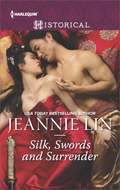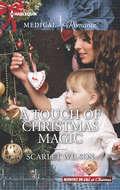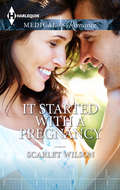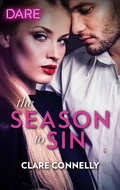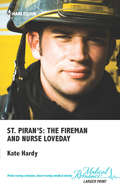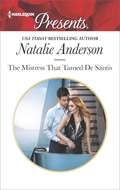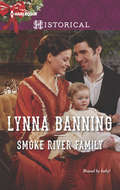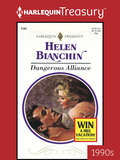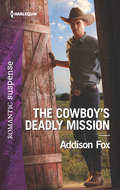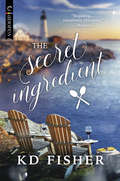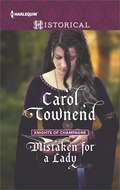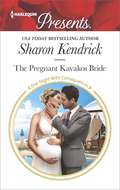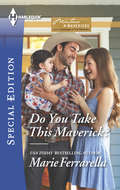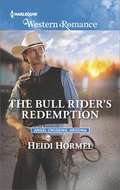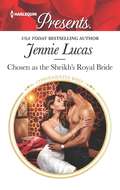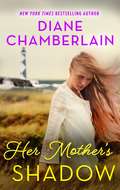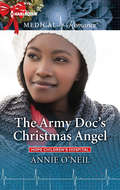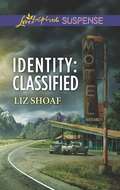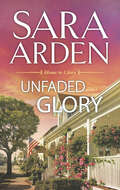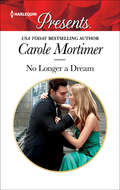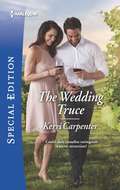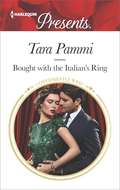- Table View
- List View
Silk, Swords and Surrender: An Anthology
by Jeannie LinBe swept away to a land of silk and swords, passion and surrender From USA TODAY bestselling author Jeannie Lin comes a tantalizing new five-story volume. Take a journey to Tang Dynasty China and join five unique heroines as they fight, seduce and steal their way into their heroes' hearts. Rediscover four reader-favorite stories and immerse yourself in The Touch of Moonlight, the brand-new sexy novella from this highly-acclaimed author!
A Touch of Christmas Magic (Midwives On-Call at Christmas #1)
by Scarlet WilsonA family to heal him? After a rocky beginning, midwife Bonnie Reid is surprised when the head obstetrician Jacob Layton offers her and her little daughter, Freya, a place to stay. Bonnie's looking for a fresh start, but she didn't expect it to be with brooding-and totally gorgeous-Jacob... Family life has never been an option for Jacob-especially after his recent cancer diagnosis. Yet the Christmas magic Bonnie and Freya bring into his home makes Jacob feel more alive than ever! It's supposed to be temporary, but can Jacob really let Bonnie go?
It Started with a Pregnancy
by Scarlet WilsonDr Cooper Roberts has a new job and the chance to begin a new life. What’s most definitely not in his plans? Waking up with his new colleague, Melissa Bell... And having to hold his head up above the dropped jaws of his fellow docs as he escorts Missy to buy a pregnancy test!
The Season to Sin: A Holiday Fling Romance (Christmas Seductions #1)
by Clare ConnellyA gorgeous, damaged man comes to me for help. And I help him…right out of his clothes!I’ve never crossed the line with a client. Never even been tempted. I didn’t spend years building a reputation as a respected psychologist just to throw it all away. Then bad-boy billionaire Noah Moore stormed into my life like a delicious disaster.Noah is so wounded, so proud, so hot he leaves me breathless with a glance. He’s not shy about asking for what he wants—me! I shouldn’t give in, yet I do. But if I’m not careful, he’ll take everything I offer—body and soul—and walk away like it was nothing. How can I give up the control, the safety I’ve fought for, to a man who is so broken?Noah tempts me to sin…and I’m powerless to resist. I’ve always been the good girl, always done the right thing. But this festive season, from his hip London loft to a luxurious Paris hotel, Noah is showing me how good it feels to be on the naughty list!Don’t forget to check out the first book in Clare Connelly’s CHRISTMAS SEDUCTIONS duet, BOUND BY THEIR CHRISTMAS BABY, available now through Harlequin Presents!Sexy. Passionate. Bold. Discover Harlequin Dare, a new line of fun, edgy and sexually explicit romances for the fearless female.
St. Piran's: The Fireman and Nurse Loveday (St. Piran's Hospital #7)
by Kate HardySchool nurse and local wallflower Flora Loveday would rather spend time with her pupils than even think about dating-until smoking-hot firefighter Tom Nicholson enters her life.... But Tom’s interest in her is just because she’s put a smile on his troubled young nephew’s face-isn’t it?While Flora’s bond with little Joey is invaluable, Tom has to admit he wants her around for other reasons. Flora has a beauty strangely overlooked by others, but Tom’s going to awaken the passion she tries desperately to hide....
The Mistress That Tamed De Santis: Demetriou Demands His Child A Ring For Vincenzo's Heir The Secret Beneath The Veil The Mistress That Tamed De Santis (The Throne of San Felipe #2)
by Natalie AndersonForbidden nights with the prince Crown prince Antonio De Santis hasn't touched a woman since the tragedy that took his fiancée. But an unexpected encounter with notorious temptress Bella Sanchez has this royal breaking his one rule...and he discovers this seductress is not what she seems! For Bella, life has been an empty performance since the injury that ended her prima ballerina career. But when Antonio demands her presence in his palace, she can't resist the stolen moments he offers. Their forbidden affair must be kept secret, but soon Bella is faced with a choice-surrender her heart, or tame the De Santis prince!
Smoke River Family: Smoke River Family The Demure Miss Manning Enticing Benedict Cole
by Lynna BanningA baby to bring them together... When Dr. Zane Dougherty swept Winifred Von Dannen's sister off to Smoke River, Winifred was resentful, but now she wants to be part of her late sister's baby's life. That means dealing with Zane and the shadows of loneliness-and incredible hunger-she sees in his eyes. Zane knows he and his infant daughter are truly blessed. But he wants more. He wants Winifred! Is there a way he can mend this broken family and care for them forever?
DANGEROUS ALLIANCE (Too Hot to Handle #6)
by Helen BianchinA Fiery, Unconventional Marriage..."Is the idea of marriage to me so unacceptable?"A seemingly innocent question, but when spoken by Dimitri Kostakidas it was deeply, disturbingly provocative. Leanne knew she was in danger of being overpowered by Dimitri's vibrant Latin sexuality....Years ago, her response might have been different: as an impressionable teenager Leanne had fancied herself in love with Dimitri. But now she would do anything rather than share his bed! There was just one problem...the heat of Dimitri's passion scorched her senses. As her husband, would he prove untamable?
The Cowboy's Deadly Mission: A Western Romantic Suspense Novel (Midnight Pass, Texas #1)
by Addison FoxIn Midnight Pass, Texas, the law is this cop’s passion…and one rancher’s problem.Ten years after they broke up, the sparks—and the enmity—between sexy cowboy Tate Reynolds and Detective Belle Granger are just as hot as ever. When a body turns up on Tate’s family ranch, headstrong Belle catches the case and falls right back into her ex’s protective arms. This time, will a savage crime unite them…or shatter their love forever?
Kiss River (The Keeper Trilogy #2)
by Diane ChamberlainReturn to Kiss River in the second emotional novel in the acclaimed trilogy from bestselling author Diane Chamberlain.Separated by a continent from her child, Gina Higgins comes to Kiss River with little more than a desperate plan. Now, saving her daughter depends on whether she can uncover a message buried deep below the ocean’s surface.Kiss River’s historic nineteenth-century lighthouse has all but fallen into the sea, taking with it the huge Fresnel lens that once served as its beacon. Gina is desperate to find a way to raise the lens; the glass holds the key to her future, her fortune and her only chance to save the one person who matters to her.Clay O’Neill lives in the old light keeper’s house, a home he shares with his sister, Lacey. When Lacey invites her to stay with them, Gina eagerly accepts. As Gina begins her quest to raise the lens, Clay finds himself drawn to her struggle, and to Gina herself.But the answers lie deep below the ocean. And the lighthouse holds secrets that neither Clay nor Gina can anticipate…Originally published in 2003
A Hero for the Holidays: A Clean Romance (Matchmaker at Work #1)
by Syndi PowellShe&’s his hero…But they&’re rescuing each other!When Christopher Fox&’s house goes up in flames, there&’s one shining light in the darkness—firefighter Penny Cuthbert. His hero may look like an angel, but the widowed father of two has no time for a romantic distraction. Still, as this strong, bright woman helps him and the kids enjoy the holidays despite all they&’ve lost, he wonders—can love grow out of the ashes?From Harlequin Heartwarming: Wholesome stories of love, compassion and belonging.
The Secret Ingredient: An Opposites-Attract Romance
by KD Fisher&“A perfectly rendered cast of characters, plenty of mouthwatering moments in the kitchen, and a completely charming small town setting.&” —BooklistTwo amazing chefs. Two very different restaurants. One recipe for love.For single mom Adah Campbell, the executive chef job at a posh restaurant in quaint South Bay, Maine is a dream come true—and the perfect opportunity to start over, far away from a home that&’s never felt entirely hers. But fitting in has never been easy, and between a new town, a new boss, and the unexpectedly attractive owner of a rival café, things get off to a rocky start.Never did free-spirited Beth Summers think she&’d still be in Maine. Travel the world gathering delicious recipes and finding friends and lovers? Absolutely. Step in to run her family&’s small-town café? Not so much. However, once Beth commits to something, that&’s it. Soon, The Yellow House is the hottest spot in town, but Beth&’s out of energy—and out of ideas for moving forward.Until Adah Campbell walks into her life. As sparks fly, both chefs have to decide if they are willing to make sacrifices...or if it&’s really too many cooks in the kitchen.Carina Adores is home to romantic love stories where LGBTQ+ characters find their happily-ever-afters.
Mistaken for a Lady: Western Christmas Proposals Kidnapped By The Highland Rogue Mistaken For A Lady (Knights of Champagne #5)
by Carol TownendWearing his ring again... When a shocking revelation reveals Francesca's illegitimacy, she worries for her marriage to Tristan, Comte des Iles. Her heart in tatters, she awaits her husband's return... Will he request an annulment or give their union a second chance? Duty has kept Tristan from his beautiful wife's side for far too long, but the memory of her touch is seared into his soul. Now, with malevolent forces working against them, it's more important than ever for Tristan to show Francesca that he'll never let her go!
The Pregnant Kavakos Bride: A Spicy Billionaire Boss Romance (One Night With Consequences #31)
by Sharon KendrickHired by the Greek billionaire... Shipping magnate Ariston Kavakos expects stunning blonde Keeley Turner to be just like her gold-digging mother. So the only way to keep her away from his brother is to make her a proposition himself: a month's employment-at his beck and call-on his private island... Her family's finances in dire straits, Keeley reluctantly accepts Ariston's offer. Soon her resistance to his smoldering good looks, and their sizzling chemistry, weakens! But their spectacular night together has an unforeseen consequence, and Ariston makes one thing clear: he won't rest until Keeley becomes his bride...
Do You Take This Maverick?: Do You Take This Maverick? The Boss, The Bride And The Baby A Reunion And A Ring (Montana Mavericks: What Happened at the Wedding? #2)
by Marie Ferrarella"I DO...I DON'T. . . I DO?" RUST CREEK RAMBLINGS The fallout from last month's wedding-to-end-all-weddings continues. Did you hear that Claire Strickland and her oh-so-handsome husband, Levi Wyatt, have called it quits? Everyone thought these two were the perfect couple with the most perfect baby. One minute they were together, the next there was a poker game and then... What could have possibly steered these two young lovebirds off course? Even though they are on the outs, rumor has it that Claire and Levi have both taken up domicile at Strickland's Boarding House. We find this behavior highly suspect-and everyone in town is weighing in, too! So don't pack your suitcases yet, dear readers-we have a feeling this love story is far from over!
False Impressions (An Izzy McNeil Novel #6)
by Laura CaldwellChicago attorney Izzy McNeil is ready to take a break from private investigation and focus on her career in criminal law. But as a favor, she agrees to work with Madeline Saga, a beautiful art gallery owner who fears that artwork she has sold is fake. Who in Madeline's tight circle of artists and gallery owners is guilty of the forgeries?When Madeline's life is threatened, Izzy is suddenly asking a more troublesome question: Who wants the gallery owner dead?As the case spins out of control, there's only one person who makes Izzy feel safe-Detective Damon Vaughn. But getting close to her former nemesis is full of surprises. Astonishing truths about the glittering Chicago art scene will introduce Izzy to the deadliest art of deception....
The Bull Rider's Redemption (Angel Crossing, Arizona #5)
by Heidi HormelBACK IN THE RING Clover Van Camp meets her match when her plans to turn a struggling Arizona town into a Wild West resort are blocked by the hunky mayor, retired bull rider Danny Leigh. To make things more complicated, this isn't the first time the two of them have tangled... Danny knows Clover usually gets her way, but this time he won't back down. He's got a few things to answer for and a town to save. Besides, reconnecting with his former fling has benefits, as long as he doesn't get distracted by their mutual attraction. Will Danny and Clover let their ambition keep their hearts divided?
Chosen as the Sheikh's Royal Bride: The Italian Demands His Heirs (billionaires At The Altar) / Chosen As The Sheikh's Royal Bride (conveniently Wed!) (Conveniently Wed! #16)
by Jennie LucasSwept from her ordinary world…into the royal bedchamber!Among the many beautiful, accomplished candidates hoping to be chosen as Sheikh Omar’s wife, shop assistant Beth can’t believe this powerful desert king would even notice her. Yet Omar does select her—and his heated gaze sets her alight, making her innocent body crave caresses she’s only dreamed about! She’s instantly thrown into his world of unimagined luxury, but can this shy Cinderella ever be a queen?A Cinderella story with a royal twist!
Her Mother's Shadow (The Keeper Trilogy #3)
by Diane ChamberlainGet swept up in the continuing emotional saga of Kiss River in this final compelling instalment of the Keeper of the Light trilogy, from New York Times bestselling author Diane Chamberlain.AnnieA loving mother and wife, Annie O’Neill was the heart of the small community of Kiss River. But her generous nature hid a darker side that remained secret for years after her tragic death.LaceyWhen Lacey O’Neill finally learns the shattering truth about the mother she’s spent a decade emulating, the foundation of her life begins to crumble. Then her close childhood friend dies, leaving her teenage daughter, Mackenzie, in Lacey’s care, and Lacey unwillingly finds herself in the role of mother.MackenzieUprooted by her mother’s death, Mackenzie resents her new home of Kiss River. She wants nothing to do with the father who never knew she existed—and especially not her mother’s oldest friend. But the person who could understand her best might be the one she resents most: Lacey.Originally published in 2004
The Army Doc's Christmas Angel (Hope Children's Hospital #3)
by Annie O'NeilLetting go of his past……to embrace their future!In this Hope Children’s Hospital story, pediatrician Dr. Finn Morgan keeps himself fiercely private—after losing his leg in Afghanistan, he pushed everyone away. So his unexpected attraction to colleague, physiotherapist Naomi Collins, infuriates him! Something in her stunning eyes tells him she’s a survivor too. Christmas is a time for healing, maybe they’ll both find what they’ve both been looking for—in each other’s arms…Hope Children’s Hospital miniseries Book 1 — Their Newborn Baby Gift by Alison RobertsBook 2 — One Night, One Unexpected Miracle by Caroline AndersonBook 3 — The Army Doc’s Christmas Angel by Annie O’NeilBook 4 — The Billionaire’s Christmas Wish by Tina Beckett “Both the main characters were fascinating and I loved their back stories, as they’re so different, and yet, they’re so great together.” Harlequin Junkie on One Night with Dr Nikolaides“Annie O’Neil is a master of her craft when it comes to feeling what her characters feel and the whole mix together is what made me adore this story.” Goodreads on Reunited with Her Parisian Surgeon
Identity: Classified (Love Insp Susp True Lp Trade Ser. #4)
by Liz ShoafUncovering the pastMay be the only way to surviveAfter security specialist Chloe Spencer witnesses a murder on her webcam, the killer faces the camera with a threat: return his disc, or she’s next. Unsure what he’s after, Chloe uses an alias and runs…until she lands in Sheriff Ethan Hoyt’s jurisdiction. When the killer finds her, Chloe must stand alone or trust Ethan—with the secrets of her past, her life…and her heart.
Unfaded Glory (Home to Glory)
by Sara ArdenIn Glory, Kansas, a fairy-tale wedding has local tongues wagging. But through this false engagement, can a wounded warrior and the woman he's protecting find true love? Byron Hawkins doesn't want to be responsible for anyone ever again. The former Black Ops soldier is better at taking lives than saving them. But on a mission in Tunisia to deliver a package to safety, Byron is dismayed to find that the precious cargo is actually a hostage rescue, and that his orders are to take Damara Petrakis back to US soil and hide her in plain sight-as his newlywed wife. Back in Byron's hometown of Glory, Kansas, petite, fierce Damara keeps surprising him; she may be royalty, but she's fully trained in martial arts and will sacrifice anything for her country. As the town rallies around the returning hero and his bride-to-be, he's finding that it's way too easy to play the part, and after the hell he has seen, that terrifies him. Byron didn't want another life to save, but the passionate beauty he's sworn to protect might just turn the tables and save him instead.
No Longer a Dream: A Millionaire Romance
by Carole MortimerRead this classic romance by USA Today bestselling author Carole Mortimer, now available for the first time in e-book! Waking up in the millionaire's bed… To research her book, author Cat Howard chases down arrogant film studio owner, Caleb Steele. But she doesn't expect to wake up naked in his bed! Five years ago, Cat's world was devastated by the death of her beloved fiancé. She's still grieving her loss, but this powerful attraction to Caleb feels oh-so right…! Cat's genuine innocence and fiery wit captivates Caleb and he's determined to claim her. But can he convince her to let go of the past…? Originally published in 1985
The Wedding Truce (Something True #2)
by Kerri CarpenterThey need to get along…For the sake of planning their best friends’ wedding shower, divorce attorney Xander Ryan and wedding coordinator Grace Harris are calling a truce. But Grace longs for her own happily-ever-after, and Xander doesn’t believe in them. So finding common ground might be a challenge. When an argument leads to a passionate kiss, neither plans to tell a soul. Because they’re all wrong for each other. Right?
Bought with the Italian's Ring: The Secret Valtinos Baby Bought With The Italian's Ring A Proposal To Secure His Vengeance Redemption Of A Ruthless Billionaire (Conveniently Wed! #2)
by Tara PammiHis lifelong legacy is at riskBuying a bride could save it…CEO Raphael Mastrantino has absolute power—until a shock heir to his billion-dollar empire emerges! He initiates a calculated seduction to rob Pia Vito of her inheritance, and inescapable hunger soon engulfs them. But Pia’s innocence unravels his plans to acquire her. Now, to make her his, Raphael must give her more than a diamond ring!
